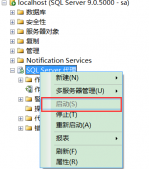1.简介:
作为DBA会经常需要检查所有的数据库或用户表,比如:检查所有数据库的容量;看看指定数据库所有用户表的容量,所有表的记录数...,我们一般处理这样的问题都是用游标分别处理处理,比如:在数据库检索效率非常慢时,我们想检查数据库所有的用户表,我们就必须通过写游标来达到要求;如果我们用sp_MSforeachtable就可以非常方便的达到相同的目的:EXEC sp_MSforeachtable @command1="print '?' DBCC CHECKTABLE ('?')"
系统存储过程sp_MSforeachtable和sp_MSforeachdb,是微软提供的两个不公开的存储过程,从mssql6.5开始。存放在SQL Server的MASTER数据库中。可以用来对某个数据库的所有表或某个SQL服务器上的所有数据库进行管理,后面将对此进行详细介绍。
2.参数说明:
@command1 nvarchar(2000), --第一条运行的SQL指令
@replacechar nchar(1) = N'?', --指定的占位符号
@command2 nvarchar(2000)= null, --第二条运行的SQL指令
@command3 nvarchar(2000)= null, --第三条运行的SQL指令
@whereand nvarchar(2000)= null, --可选条件来选择表
@precommand nvarchar(2000)= null, --执行指令前的操作(类似控件的触发前的操作)
@postcommand nvarchar(2000)= null --执行指令后的操作(类似控件的触发后的操作)
以后为sp_MSforeachtable的参数,sp_MSforeachdb不包括参数@whereand
3.使用举例:
--统计数据库里每个表的详细情况:
exec sp_MSforeachtable @command1="sp_spaceused '?'"
--获得每个表的记录数和容量:
EXEC sp_MSforeachtable @command1="print '?'",
@command2="sp_spaceused '?'",
@command3= "SELECT count(*) FROM ? "
--获得所有的数据库的存储空间:
EXEC sp_MSforeachdb @command1="print '?'",
@command2="sp_spaceused "
--检查所有的数据库
EXEC sp_MSforeachdb @command1="print '?'",
@command2="DBCC CHECKDB (?) "
--更新PUBS数据库中已t开头的所有表的统计:
EXEC sp_MSforeachtable @whereand="and name like 't%'",
@replacechar='*',
@precommand="print 'Updating Statistics.....' print ''",
@command1="print '*' update statistics * ",
@postcommand= "print''print 'Complete Update Statistics!'"
--删除当前数据库所有表中的数据
sp_MSforeachtable @command1='Delete from ?'
sp_MSforeachtable @command1 = "TRUNCATE TABLE ?"
4.参数@whereand的用法:
@whereand参数在存储过程中起到指令条件限制的作用,具体的写法如下:
@whereend,可以这么写 @whereand=' AND o.name in (''Table1'',''Table2'',.......)'
例如:我想更新Table1/Table2/Table3中NOTE列为NULL的值
sp_MSforeachtable @command1='Update ? Set NOTE='''' Where NOTE is NULL',@whereand=' AND o.name in (''Table1'',''Table2'',''Table3'')'
5."?"在存储过程的特殊用法,造就了这两个功能强大的存储过程.
这里"?"的作用,相当于DOS命令中、以及我们在WINDOWS下搜索文件时的通配符的作用。
6.小结
有了上面的分析,我们可以建立自己的sp_MSforeachObject:(转贴)
USE MASTER
GO
CREATE proc sp_MSforeachObject
@objectType int=1,
@command1 nvarchar(2000),
@replacechar nchar(1) = N'?',
@command2 nvarchar(2000) = null,
@command3 nvarchar(2000) = null,
@whereand nvarchar(2000) = null,
@precommand nvarchar(2000) = null,
@postcommand nvarchar(2000) = null
as
/* This proc returns one or more rows for each table (optionally, matching @where), with each table defaulting to its
own result set */
/* @precommand and @postcommand may be used to force a single result set via a temp table. */
/* Preprocessor won't replace within quotes so have to use str(). */
declare @mscat nvarchar(12)
select @mscat = ltrim(str(convert(int, 0x0002)))
if (@precommand is not null)
exec(@precommand)
/* Defined @isobject for save object type */
Declare @isobject varchar(256)
select @isobject= case @objectType when 1 then 'IsUserTable'
when 2 then 'IsView'
when 3 then 'IsTrigger'
when 4 then 'IsProcedure'
when 5 then 'IsDefault'
when 6 then 'IsForeignKey'
when 7 then 'IsScalarFunction'
when 8 then 'IsInlineFunction'
when 9 then 'IsPrimaryKey'
when 10 then 'IsExtendedProc'
when 11 then 'IsReplProc'
when 12 then 'IsRule'
end
/* Create the select */
/* Use @isobject variable isstead of IsUserTable string */
EXEC(N'declare hCForEach cursor global for select ''['' + REPLACE(user_name(uid), N'']'', N'']]'') + '']'' + ''.'' + ''['' +
REPLACE(object_name(id), N'']'', N'']]'') + '']'' from dbo.sysobjects o '
+ N' where OBJECTPROPERTY(o.id, N'''+@isobject+''') = 1 '+N' and o.category & ' + @mscat + N' = 0 '
+ @whereand)
declare @retval int
select @retval = @@error
if (@retval = 0)
exec @retval = sp_MSforeach_worker @command1, @replacechar, @command2, @command3
if (@retval = 0 and @postcommand is not null)
exec(@postcommand)
return @retval
GO
这样我们来测试一下:
--获得所有的存储过程的脚本:
EXEc sp_MSforeachObject @command1="sp_helptext '?' ",@objectType=4
--获得所有的视图的脚本:
EXEc sp_MSforeachObject @command1="sp_helptext '?' ",@objectType=2
--比如在开发过程中,没一个用户都是自己的OBJECT OWNER,所以在真实的数据库时都要改为DBO:
EXEc sp_MSforeachObject @command1="sp_changeobjectowner '?', 'dbo'",@objectType=1
EXEc sp_MSforeachObject @command1="sp_changeobjectowner '?', 'dbo'",@objectType=2
EXEc sp_MSforeachObject @command1="sp_changeobjectowner '?', 'dbo'",@objectType=3
EXEc sp_MSforeachObject @command1="sp_changeobjectowner '?', 'dbo'",@objectType=4
这样就非常方便的将每一个数据库对象改为DBO.
系统存储过程sp_MSforeachtable和sp_MSforeachdb使用说明
2019-11-15 14:59mssql教程网 Sql Server
系统存储过程sp_MSforeachtable和sp_MSforeachdb使用说明
延伸 · 阅读
- Sql Server

SQL_Server全文索引的用法解析
SQL Server全文索引相信大家都有一定的了解,下面就为您介绍SQL Server全文索引的用法及相关的语句,希望可以让您对SQL Server全文索引能有更深的认识 ...
- Sql Server

SQL2005 存储过程解密方法
SQL2005 存储过程解密方法,需要的朋友可以参考下。...
- Sql Server

SQLServer 数据库的数据汇总完全解析(WITH ROLLUP)
乍一看,好像很容易,用group by好像能实现?但仔细研究下去,你又会觉得group by也是无能为力,总欠缺点什么,无从下手。那么,到底该如何做呢?别急,...
- Sql Server

SQL JOIN 连接详细介绍及简单使用实例
这篇文章主要介绍了SQL JOIN 连接详细介绍及简单使用实例的相关资料,需要的朋友可以参考下 ...
- Sql Server

SQLServer2005 批量查询自定义对象脚本
SQLServer2005 批量查询自定义对象脚本,使用系统函数object_definition和系统表 sysobjects 就可以了 ...
- Sql Server

深入SQLServer中ISNULL与NULLIF的使用详解
本篇文章是对SQLServer中ISNULL与NULLIF的使用进行了详细分析介绍,需要的朋友参考下 ...
- Sql Server

SQLServer2005创建定时作业任务
这篇文章主要为大家介绍了SQLServer2005创建定时作业任务的详细过程,具有一定的参考价值,感兴趣的小伙伴们可以参考一下 ...
- Sql Server

三种SQL分页查询的存储过程代码
三种SQL分页查询的存储过程代码,需要的朋友可以参考下。 ...












